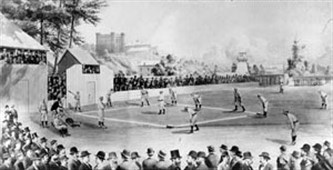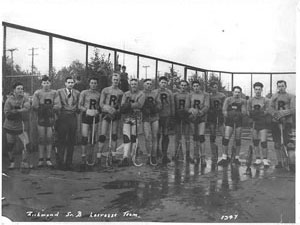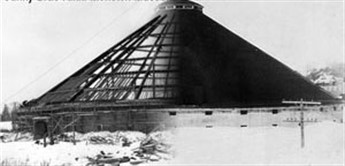Take me out with the crowd... Canada’s Sports Heritage
Canada is known for many attributes but there are two in
particular which we most commonly ascribe to our nation: the
weather and sports. In fact, former Prime Minister Pierre E.
Trudeau once expressed that "Canada is a country whose main exports
are hockey players and cold fronts." While it is true that
discussions of the weather often dominate Canadian rhetoric, it is
our long tradition of sporting heritage that we take pride in and
love to analyze and debate. For over a century this country
has produced many celebrated and world-renowned athletes in a
variety of amateur and professional sports.
There is no denying it, Canadians love their sports.
Whether engaging in or being an enthusiast of athletic pursuits, it
is irrefutable that sports have helped define both our sense of
local and national identity. From coast to coast, the places
where this understanding of community has been and continues to be
played out remain ever-present in the landscape. A number of
these sites, whether open fields or enclosed arenas, have been
recognized and designated by various levels of government for their
contributions and importance to the community and many are
currently celebrated on the Canadian Register of Historic
Places.
Although considered the American pastime today, baseball in
Canada has deep roots dating back to the game's nineteenth century
development. In fact, the first recorded baseball game in
Canada was played in Beachville (near Woodstock), Ontario, on 4
June 1838. This contest was to honour the birthday of King
George IV. Since that time, ball diamonds like Labatt Memorial Park in London, Ontario have
become standard features in many communities. Originally
called Tecumseh Park, this ball park is believed to be the world's
oldest facility continuously used for baseball. It was
established in 1877 and includes a grandstand, bleachers built in
1877, and a 1937 clubhouse.
 A more overlooked aspect
of Canadian sporting history, akin to the game of baseball, is the
tradition of cricket in Canada. First played in colonial
Canada in the eighteenth century, it was then a game popular among
British soldiers garrisoned in British North America.
Throughout the nineteenth century many cricket societies were
formed including the Ottawa Cricket Club who built a handsome Cricket Clubhouse on the grounds of Rideau
Hall, the official residence of Canada's Governor-General in
Ottawa, Ontario. The clubhouse and field continue to serve
the cricket community.
A more overlooked aspect
of Canadian sporting history, akin to the game of baseball, is the
tradition of cricket in Canada. First played in colonial
Canada in the eighteenth century, it was then a game popular among
British soldiers garrisoned in British North America.
Throughout the nineteenth century many cricket societies were
formed including the Ottawa Cricket Club who built a handsome Cricket Clubhouse on the grounds of Rideau
Hall, the official residence of Canada's Governor-General in
Ottawa, Ontario. The clubhouse and field continue to serve
the cricket community.
Lacrosse, Canada's official summer sport, has a long history,
some of which belongs more to the realm of legend than of
fact. An activity originally developed by First Nations, the
modern era of lacrosse emerged in the mid-nineteenth century; the
first international match occurred in 1844 when Canada confronted
the USA in New York City and, in 1860, the game's rules were
codified by a Montreal dentist, William George Beers. On the
West Coast, organized box lacrosse, a branch of the traditional
game, was a major activity at the turn of the twentieth century and
this history can be appreciated at places like the Brighouse Lacrosse Box in Richmond, British
Columbia.
 A discussion of Canadian
sports would not be complete without a reference to Canada's
official winter sport: hockey. The first indoor match took
place in Montreal on 3 March 1875 among McGill University
students. Hockey rinks, whether a backyard ice surface or
professional arena, are a staple facility in most communities
across Canada. One of the more unique architectural examples
of this building type is the Sunny Brae Rink in Moncton, New
Brunswick. Completed in 1922, the structure was inspired by
the circular arenas of ancient Rome and adorned by a conical roof
which was destroyed by fire in 1928. While in use, though,
the arena was the largest of its kind in the Maritimes.
A discussion of Canadian
sports would not be complete without a reference to Canada's
official winter sport: hockey. The first indoor match took
place in Montreal on 3 March 1875 among McGill University
students. Hockey rinks, whether a backyard ice surface or
professional arena, are a staple facility in most communities
across Canada. One of the more unique architectural examples
of this building type is the Sunny Brae Rink in Moncton, New
Brunswick. Completed in 1922, the structure was inspired by
the circular arenas of ancient Rome and adorned by a conical roof
which was destroyed by fire in 1928. While in use, though,
the arena was the largest of its kind in the Maritimes.
No matter your level of involvement in sports, fans of all sorts
as well as amateur and professional athletes alike can appreciate
Canada's storied places where the drama of competition unfolded,
giving rise to scenes at times of excitement, at other times of
tragedy. While it is undeniable that sports have the power to
unite us and build stronger communities, the places which support
athletic activities are valued beyond their role for hosting
sporting events. Sports facilities, such as those highlighted
here, have equally supported other collective events facilitating
healthy and sustainable communities. Three cheers for our
places of sport; let us continue to celebrate and enjoy
them. Hip, hip, hurrah!